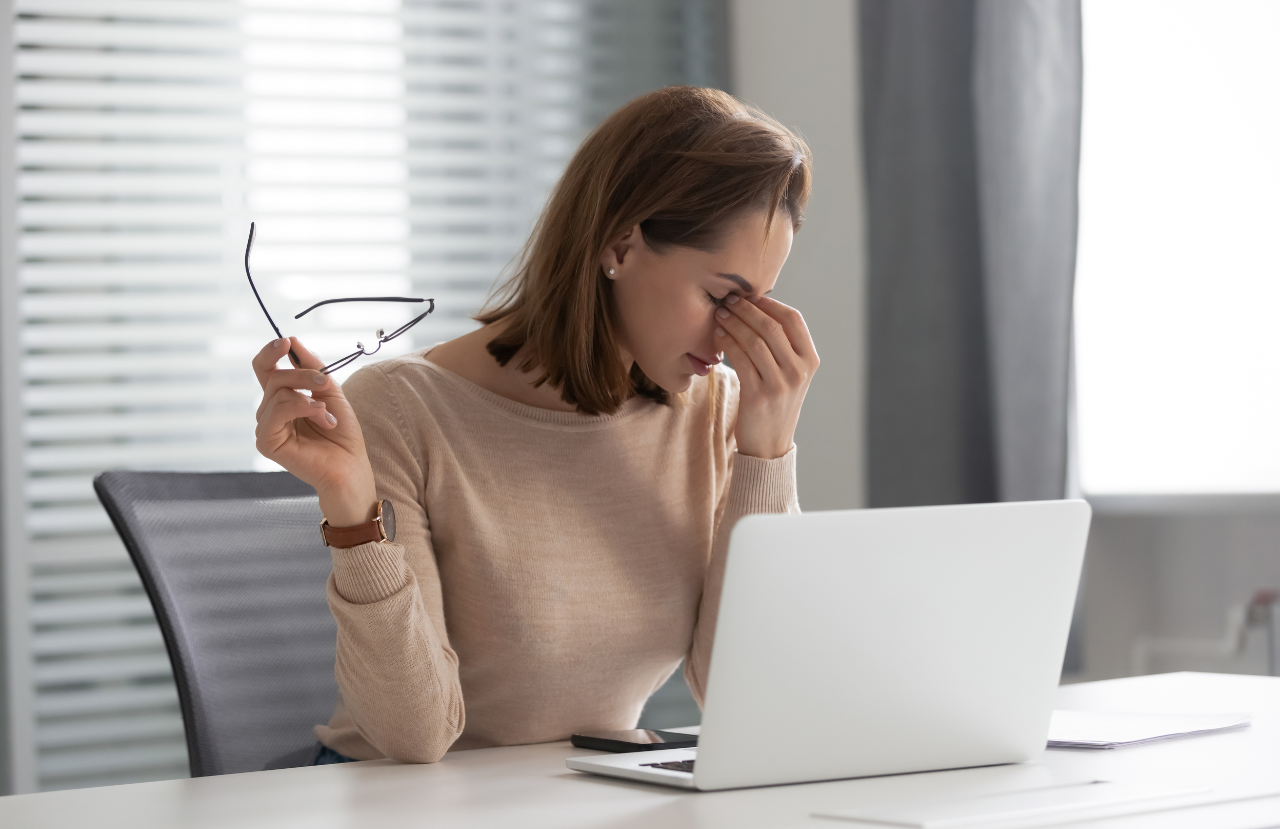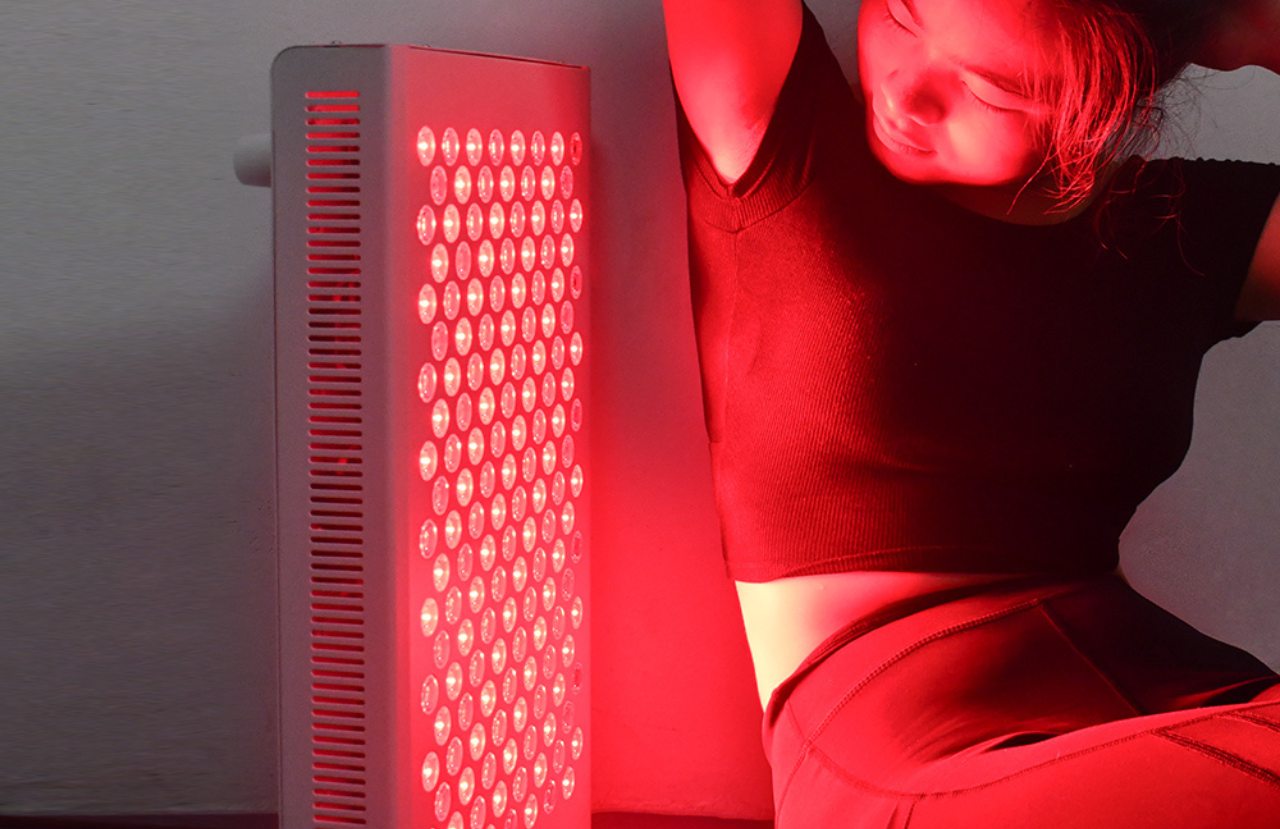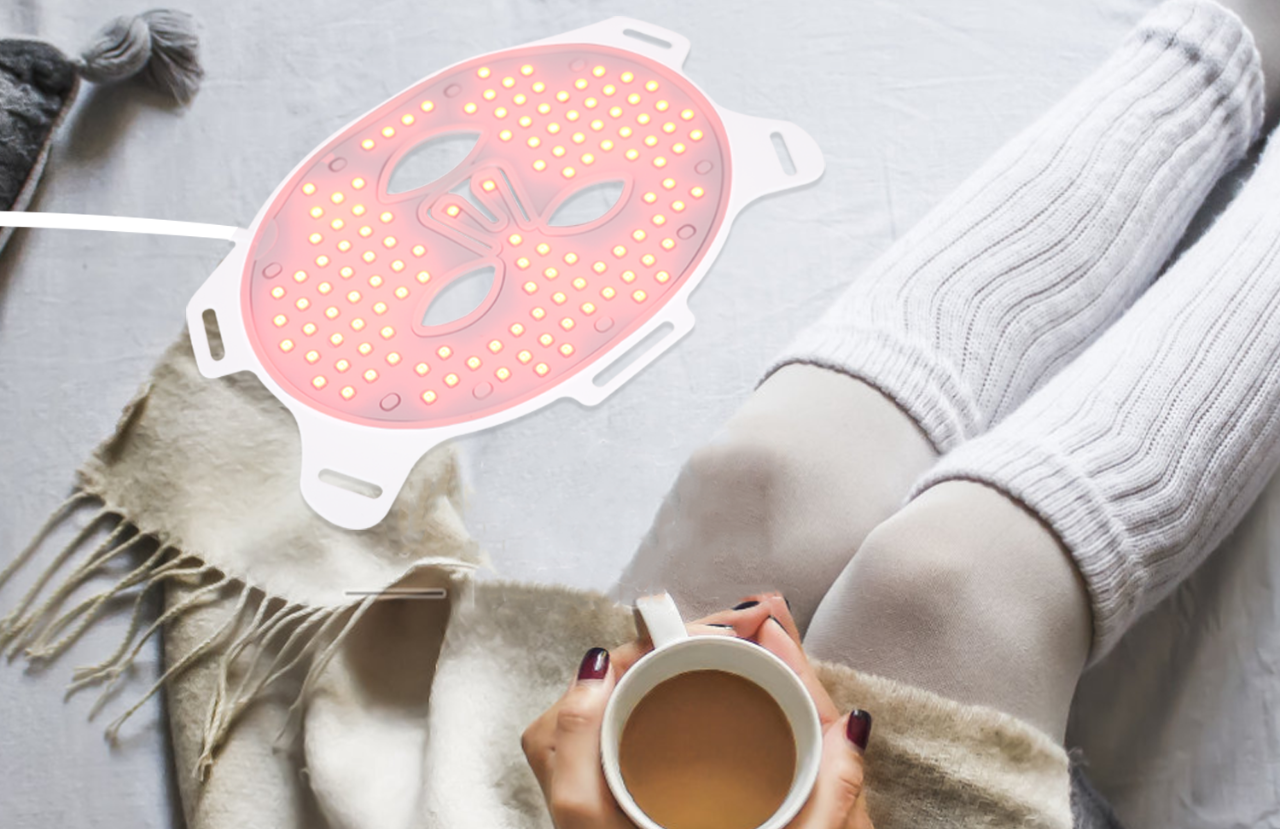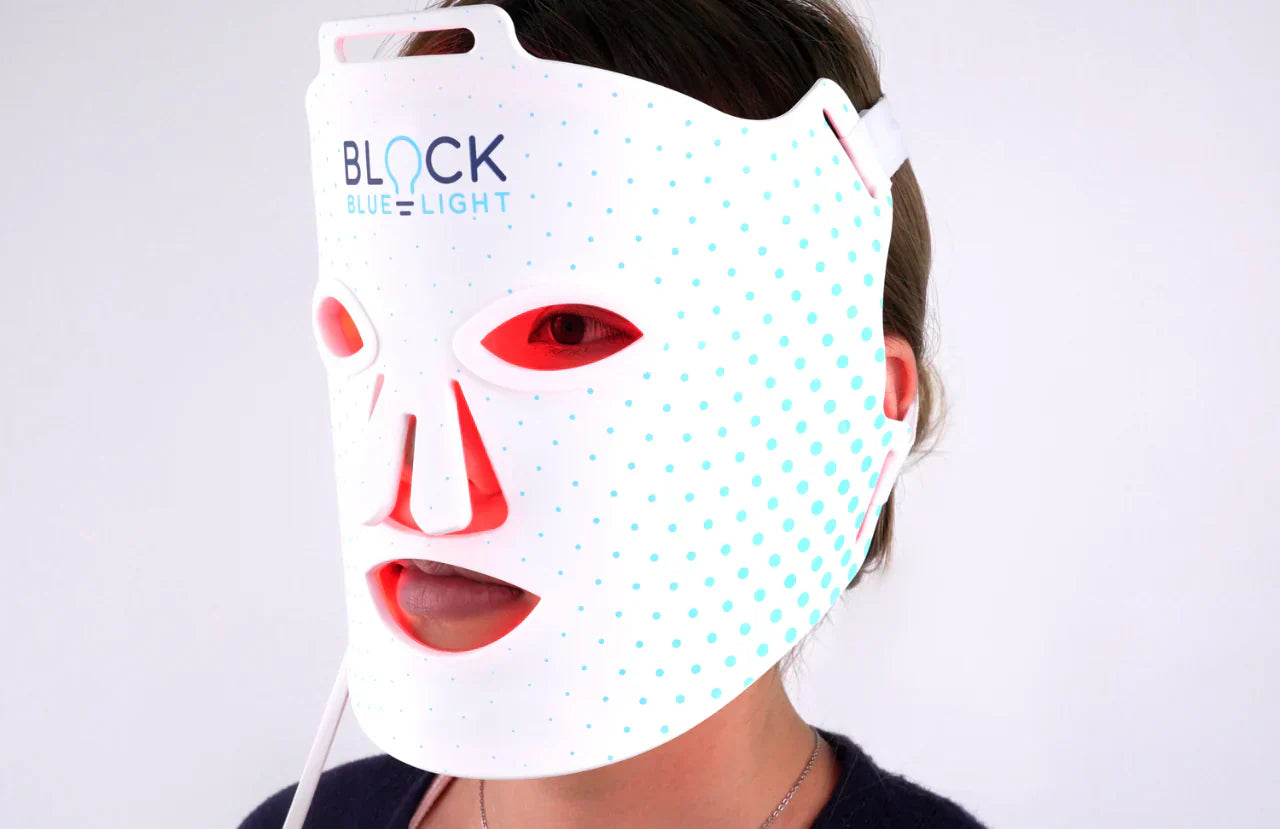Jump To Section
- The Visible Light Spectrum
- Common Sources of Blue Light and the Problem with Artificial Light
- The Risks of Artificial Blue Light to Eye Health
- Who is more at Risk from Blue Light?
- How to Protect Your Eyes from the Effects of Artificial Blue Light
Are you someone who spends a lot of time in front of a computer or other digital device? Do you work under bright lights all day? If you frequently suffer from headaches, sore and fatigued eyes, dry eyes or blurry vision, you may be struggling with digital eye strain. Blue Light Computer Glasses are one excellent way to combat this issue.
In this article, we'll explore the impact that digital devices and artificial lighting have on our eyes and what we can do to mitigate it.
The Visible Light Spectrum

Our eyes are sensitive to a very small spectrum of light, from 380-700 nanometres (nm). It appears white to us but contains an array of blue, green, yellow, orange and red waves. Beyond this visible spectrum are infrared and ultraviolet light waves.
Light on the orange-red end of the spectrum (590-700nm) has long wavelengths, while light on the blue-green (380-500nm) side of the spectrum has short, high-energy wavelengths. When it comes to our eyes, it's the high-energy light we need to be concerned about (1).
Common Sources of Blue Light and the Problem with Artificial Light

The largest source of blue light is sunlight. These light waves scatter as they collide with air and water molecules in the atmosphere, resulting in blue skies on a clear day.
Getting enough natural blue light – particularly in the 465-495nm range – is vital for health and wellness. It regulates our circadian rhythm to maintain healthy sleep and wake cycles, as well as other rhythms like appetite and hormone release (2). Natural light exposure also boosts our memory, mood, energy, alertness and feelings of well being.
Blue light isn't new, but what is new is our rate of exposure to artificial sources from:
- Flatscreen TVs
- Smartphones
- Tablets
- Gaming devices
- Computers
- Fluorescent lights
- LED lights
It's pretty much guaranteed that you rely heavily on some form of digital device throughout the day (and evening). Shockingly, most people spend more than 6 hours a day in front of a digital device and some as much as 10-12 hours. While the light from screens appears white to us, the majority of the light emitted is blue light in the range of 400-490nm.
Our round-the-clock use of devices means we're bombarded with man-made light when our body should be winding down for sleep. Research shows that exposure to blue light in the evening suppresses the "sleep hormone" melatonin which disrupts our sleep and circadian rhythm (3).
But what are we doing to our eyes by using these bright light sources for prolonged periods so close to our face?
Keep reading to find out why ophthalmologists and optometrists are concerned about the effect of this light on eye health and vision.
The Risks of Artificial Blue Light to Eye Health

Artificial high-energy blue light waves are dangerous to our eyes, especially in the range of 415-455nm (4). This side of the spectrum is powerful enough to penetrate through the cornea and lens to the retina at the back of the eye. It causes oxidative damage and injury to photoreceptor cells in the retina, putting enormous stress on our eyes (5).
Another factor is "flicker" from indoor lighting. The alternating current that powers conventional fluorescent and LED bulbs causes them to fluctuate in brightness many times per second, resulting in flicker. Although the flicker is largely invisible to us nowadays, it is still noticed by the brain and irritates the eyes and nervous system (6).
Eye Strain and Fatigue

If you find yourself rubbing irritated eyes after working at the computer or scrolling through Instagram, you're suffering from eye strain.
Eye strain and fatigue are common symptoms of prolonged time spent at close proximity to screens or under bright artificial lights (7).
The blue light scatters easily and creates a kind of “visual noise." We don't know it, but our eyes have to work extremely hard to focus and continually refocus this light. Plus, flicker from compact fluorescent and LED home and office lighting is stressful on our eyes.
Eye strain is sometimes called "computer eye syndrome" and causes:
- Sore and tired eyes
- Eye irritation and redness
- Burning and itching eyes
- Excessive eye watering
- Blurry vision or double vision
- Difficulty concentrating
- Headaches
- Sensitivity to light
A 2017 study found that when adults were exposed to tablet screens for one hour they noticed increased symptoms of eye strain and fatigue (8). That was just after one hour!
Sadly, these symptoms impact productivity and may make you prone to mistakes.
Dry Eyes

Another symptom that commonly accompanies prolonged screen exposure and eye strain is dry eyes that feel gritty.
A 2018 study on people using a computer for 8 hours per day found they had significantly drier eyes at the end of the day compared to people who only used a computer for 1 hour daily (9). This is because staring at screens reduces our blink rate from approximately 20 times per minute to just 1-3 times per minute, causing moisture to evaporate from the cornea.
Retinal Damage
The retina is a thin layer of tissue at the back of the eyeball made up of light-sensitive photoreceptor cells. It receives light and converts it into a neural signal sent to the brain via the optic nerve to create vision. It's amazing how sight works!
This makes the retina essential for vision, and any damage could be devastating. Sadly, there is a major risk of damage from artificial blue light exposure.
Researchers have found blue light has a crazy effect on retinal – a form of vitamin A, essential for eyesight and found in the retina. Blue light exposure appears to change it into a toxic compound that "poisons" photoreceptor cells and kills them (10)!
Macular Degeneration

As we've seen, blue light is dangerous to photoreceptors in the eye. It causes cumulative damage and is a major risk factor in the pathogenesis of macular degeneration – one of the most common causes of poor vision and blindness – along with a bad diet and smoking (11).
In this condition, photoreceptors in a part of the retina called the macular are progressively oxidized and destroyed.
Headaches and Migraines

Spending a lot of time in front of devices or working under bright fluorescent and LED lights is bad news for those prone to headaches or migraines.
You may be familiar with the light sensitivity that comes along with a headache or migraine, but migraines are a common symptom of eye strain and artificial light may trigger these painful episodes (12).
A 2015 study on teenagers with excessive use of electronic devices found that 80% reported suffering frequent headaches and migraines (13).
Nearsightedness
Our constant use of screens close up may be contributing to the growing problem of myopia – or nearsightedness – in children. This, in addition to less time spent outdoors in natural light and lack of quality sleep, is increasing the risk (14).
It's believed that the short, high-energy wavelengths from blue light stimulate myopia, and ambient lighting from fluorescents and LEDs has also been found to play a role (15). Working on a screen for prolonged periods under bright lights is a double whammy.
It's worrying because myopia also causes fatigue, eye strain and headaches. Plus, it increases the risk of eye conditions like retinal detachment, cataracts and glaucoma (16).
Who is more at Risk from Blue Light?

It must be noted that children are more at risk for eye damage from blue light. Their eyes are not yet fully developed and the lens and cornea absorb much more light than adult eyes (17). This is scary when we think about how much time children and teenagers spend in front of digital devices, whether for recreation or schoolwork.
People with light coloured eyes (blue or green) are also more sensitive to blue light as they don't have much pigment that could offer a small amount of protection (18).
Additionally, smokers and people with a family history of macular degeneration should take extra care.
How to Protect Your Eyes from the Effects of Artificial Blue Light
We've compiled a list of simple tips to mitigate the impact of blue light without changing your life significantly. Follow them to protect your eyes and overall health.
Use Blue Light Blocking Glasses
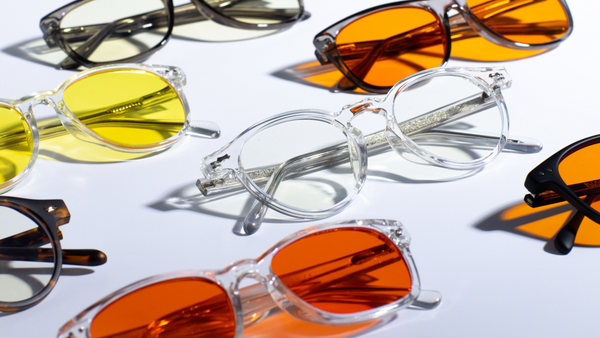
Just as we use sunglasses to keep our eyes safe from UV damage, we need protection from screen time and bright room lighting. One of the best ways to protect our eyes from digital strain is to use blue light blocking glasses.
We suggest wearing our trendy and comfortable ScreenTime computer and gaming glasses during the day when working at a computer or using any other screens. The lenses are designed to block out over 50% of blue and green light from 380-500nm. Wearing them will make your eyes feel comfortable when working in front of screens for prolonged periods.
In the evening, relax your eyes and encourage healthy sleep cycles by using our orange-tinted and red-tinted blue light glasses. They offer amazing protection and should be worn 2-3 hours before bed.
Use Blue Light Filters
As more and more research on the risks of blue light comes out, smartphones and tablets now come with a built-in blue light filter to make your device more eye-friendly.
Not all devices offer this option, but there are free apps and software programs available for smartphones, tablets, and computer screens. They filter out blue light without significantly changing the display.
Software like F.lux, Twilight and Iris reduce eye damage, eye strain, fatigue and headaches by automatically changing the colour temperature of the screen based on the time of day. You don't even have to think about it!
Change Your Light Bulbs

For the health of our eyes, we must move away from using fluorescent lights and conventional bright white LED lights that emit lots of blue light and flicker.
We recommend making use of as much natural light in your office and home and replacing the bulbs in your home with our orange and red light bulbs.
BlockBlueLight's warm, orange Sweet Dreams bulbs offer enough illumination for reading, working and cooking. These are the only LED bulbs that block out 100% of blue wavelengths up to 530nm. Plus, they are completely flicker-free, providing constant light that won't irritate your nervous system.
One study found that filtering out 94% of the blue component from artificial light protects the retina and photoreceptor cells (19).
Start by replacing the bulbs in the rooms that you spend the most time in – like the bedrooms, kitchen, office and living room. If your workplace uses cool white LED or fluorescent lighting, suggest they change their bulbs to a warmer colour to improve productivity.
Our Twilight red light bulbs are great to use for reading lamps, nurseries, children's rooms, bathrooms and hallways. It offers enough light to see at night but contains only red light and absolutely no blue or green light. It is relaxing on the eyes and will not disrupt melatonin production.
Use Soft Desk and Reading Lamps

To avoid eyestrain, we need enough illumination when working, reading or playing. Too little light makes our eyes work harder, and too much bright overhead light contributes to glare and eyestrain.
The best option is to use soft, warm light that doesn't emit blue light and won't cause glare against your screen. Replace your desk lamp with our orange Sweet Dreams bulbs.
For books, notepads, e-readers and tablets, we offer a portable NoBlue Book Light that emits amber light. It is 100% free of blue light and flicker. It clips securely and easily onto the edge of your book or device and has a flexible neck that can be adjusted to suit your needs.
Take Regular Breaks

To avoid eye strain and fatigue, give your eyes and brain frequent breaks.
- Use the 20-20-20 rule recommended by the American Optometric Society. Take a 20-second break every 20 minutes to look at something 20 feet away.
- Schedule 15-minute breaks away from screens every 2 hours
- Close your eyes for a minute every hour
- Take a break outside in natural light when possible
- Make a conscious effort to relax your neck and shoulders frequently
- Take regular short walks during the day – even if it's just around the office
- If you can, sit near a window with natural light
Adjust Your Screens
The distance and angle we view our screens from plays a major factor in digital eye strain. Follow these tips to reduce this risk:
- Keep your handheld devices – smartphones, tablets, etc. – at a distance of about 10-15 inches away from your face and just below eye level. Use a pillow under your forearms if you need help raising the device
- Increase the size of your text on your devices so you don't need to strain
- Position your laptop or computer screen directly in front of you, about 20-30 inches away from your face
- Angle your laptop screen or computer monitor about 10 degrees below horizontal eye level
- Reduce the brightness of your device to 50-60%
- Invest in an anti-glare computer monitor
- Remove dust and fingerprints from your computer or device screen so you can focus easily
Blink More and Use Eye Drops

We know that staring at a screen significantly reduces our blink rate and results in dry eyes. So, we need to remind ourselves to blink more often. You could set a reminder on your phone or put a post-it note up in your cubicle to remind you.
Unfortunately, we won't always get this right, especially when absorbed in work, study or play. Another option is to speak to your pharmacist or eye doctor about using some gentle, lubricating eye drops to reduce dry eyes and feelings of strain.
Set Screen Time Limits
The research shows that limiting screen time is best for our health and wellbeing. It may not always be easy, but setting time limits and "digital curfews" are great habits to give our eyes a break and prevent damage. This is especially important for children as their eyes are more sensitive.
- Limit your non-essential screen time each day and use a timer to keep track
- Set rules around screen time for your children
- Only allow children under 5 years old one hour of screen time daily
- Create "screen-free zones" in certain areas of the house
- Set a digital curfew and turn off all devices 2 hours before bed to wind down
- Remove all digital devices from the bedroom
You'll likely notice an improvement in your sleep, productivity and relationships!
Maximize Your Intake of Antioxidants and Micronutrients

Besides light exposure, the health of our eyes is greatly influenced by lifestyle factors like smoking, exercise and diet. One of the most useful things we can do is increase our consumption of antioxidants that protect our eyes from oxidative damage.
Antioxidant carotenoids like beta-carotene, lutein and zeaxanthin accumulate in a yellow tissue in the eye called the retinal pigment epithelium (RPE). They offer natural protection against the damaging effects of harsh blue light by absorbing some of this light and reducing the risk of macular degeneration (20).
An interesting 2008 study found that people with low levels of the nutrients vitamin C, vitamin E, zeaxanthin and zinc had a greater risk of eye damage from blue light exposure (21).
Additionally, research shows that the antioxidant vitamin E stops the death of photoreceptor cells due to blue light exposure (9).
To protect our eyes, we must consume these antioxidants and nutrients through the diet. We suggest adding more of the following foods to your diet:
- Leafy green vegetables
- Broccoli
- Brightly coloured fruits and vegetables – especially orange varieties
- Eggs
- Nuts and seeds
- Whole grains
Final Thoughts
Our exposure to artificial blue light is growing as technology advances, and the impact on our eye health is serious.
Fortunately, many of the symptoms – like eye strain, fatigue and headaches – are temporary and can be prevented or relieved by adopting the tips outlined in this article. Prevention is always better than cure!
Resources
- Zhao et al. (2018). Research progress about the effects and prevention of blue light on eyes. Available at: https://www.ncbi.nlm.nih.gov/pmc/articles/PMC6288536/
- Hastings et al. (2007). Circadian clocks: regulators of endocrine and metabolic rhythms. Available at: https://www.ncbi.nlm.nih.gov/pubmed/17951531
- Gooley et al. (2011). Exposure to room light before bedtime suppresses melatonin onset and shortens melatonin duration in humans. Available at: https://www.ncbi.nlm.nih.gov/pmc/articles/PMC3047226/
- Arnault et al. (2013). Phototoxic action spectrum on a retinal pigment epithelium model of age-related macular degeneration exposed to sunlight normalized conditions. Available at: https://www.ncbi.nlm.nih.gov/pubmed/24058402/
- Jaadane et al. (2015). Retinal damage induced by commercial light emitting diodes (LEDs). Available at: https://www.ncbi.nlm.nih.gov/pubmed/25863264/
- Rider et al. (2012). Risk assessment for LED lighting flicker. Available at: https://www.researchgate.net/publication/273660125_Risk_assessment_for_LED_lighting_flicker
- Rosenfield M. (2011). Computer vision syndrome: a review of ocular causes and potential treatments. Available at: https://www.ncbi.nlm.nih.gov/pubmed/21480937/
- Kim et al. (2017). Visual fatigue induced by viewing a tablet computer with a high-resolution display. Available at: https://www.ncbi.nlm.nih.gov/pubmed/28914003/
- Akkaya et al. (2018). Effects of long-term computer use on eye dryness. Available at: https://www.ncbi.nlm.nih.gov/pmc/articles/PMC6371992
- Chemists discover how blue light from digital devices speeds blindness. (2018). Available at: https://www.sciencedaily.com/releases/2018/08/180808093907.htm
- Algvere et al. (2006). Age-related maculopathy and the impact of blue light hazard. Available at: https://www.ncbi.nlm.nih.gov/pubmed/16445433/
- Electronic screen exposure is associated with migraine in young adults. (2016). Available at: https://www.mdedge.com/neurology/article/106245/headache-migraine/electronic-screen-exposure-associated-migraine-young
- Xavier et al. (2015). Prevalence of headache in adolescents and association with use of computer and videogames. Available at: https://www.ncbi.nlm.nih.gov/pubmed/26602725/
- He at al. (2015). Effect of time spent outdoors at school on the development of myopia among children in China: A randomized clinical trial. Available at: https://www.ncbi.nlm.nih.gov/pubmed/26372583
- Too much screen time linked to an epidemic of myopia among young people. (2019). Available at: https://theconversation.com/amp/too-much-screen-time-linked-to-an-epidemic-of-myopia-among-young-people-111599
- Why myopia progression is a concern. Available at: https://www.allaboutvision.com/parents/myopia-progression.htm
- Kozeis N. (2009). Impact of computer use on children's vision. Available at: https://www.ncbi.nlm.nih.gov/pmc/articles/PMC2776336/
- Myth or fact: People with light eyes are more sensitive to sunlight. (2013). Available at: https://www.dukehealth.org/blog/myth-or-fact-people-light-eyes-are-more-sensitive-sunlight
- Vicente-Tejedor et al. (2018). Removal of the blue component of light significantly decreases retinal damage after high intensity exposure. Available at: https://www.ncbi.nlm.nih.gov/pubmed/29543853/
- Ma et al. (2012). Improvement of retinal function in early age-related macular degeneration after lutein and zeaxanthin supplementation: a randomized, double-masked, placebo-controlled trial. Available at: https://www.ncbi.nlm.nih.gov/pubmed/22835510/
- Fletcher et al. (2008). Sunlight exposure, antioxidants, and age-related macular degeneration. Available at: https://www.ncbi.nlm.nih.gov/pubmed/18852418

